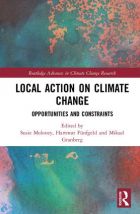Local Action on Climate Change: Opportunities and Constraints

Edited by Moloney, Fuenfgeld and Granbery, Local Action on Climate Change: Opportunities and Constraints brings together seven case studies from around the world. At a time when climate change is firmly on the agenda of decision-makers and planners, and the complexity of this challenge calls for coordinated, multi-level and multi-scalar action, this book is an important contribution. By collating different experiences, it contributes to “the ongoing research and policy dialogue on local climate change responses” (page 1).
Local Action on Climate Change comprises nine chapters. Chapter 1 sets the context for climate change action and identifies conditions that either constrain or enable innovation and transformation at the local level. It then provides a thorough overview of each case study chapter.
Chapter 2 looks at two case studies within the state of Victoria, Australia: the city of Greater Geelong, and the adaptation work of a “climate change alliance” that encompasses local governments within Melbourne’s western metropolitan region (page 18). These allow the role of different forms of collaboration in local planning and decision-making to be examined at two scales. They also enable an assessment of how governance catalyses different local climate change adaptation and mitigation (page 17).
The peri-urban spaces in Great Port Vila in Vanuatu are the focus of Chapter 3. The author examines the “dualities of urban governance and agency” in light of efforts to build the city’s climate resilience (page 36). He proposes that local modes of knowledge, previously excluded from decision-making, can be an important source of community-level resilience.
Chapter 4 presents a study of three municipal climate change adaptation plans in South Africa, which are supported by the Western Cape Government’s Climate Change Municipal Support Programme (page 54). By assessing their adaptation planning processes, the authors identify the importance of political will and suitable leadership, collaborative and integrative approaches, and mainstreaming of climate change into development planning as three key lessons.
Intended to create a more nuanced understanding of how climate change action is framed locally, Chapter 5 studies two urban areas in Japan. Through this the diversity of social, historical and geographical factors is highlighted for contributing to specific climate change policy responses (page 73). The chapter also concludes with the importance of linking climate action with other fiscal and social benefits.
Chapter 6 examines local climate change action in the Indian urban settlements of Bangalore and Chennai and their ability to respond to climate-related challenges (page 92). In particular it looks at local government planning. Similarly to Chapter 5, this chapter argues that localized climate action needs to link with existing concerns as well as operate within existing government frameworks.
Considered a pioneer in environmental governance, Sweden and its city of Karlstad are the focus of Chapter 7. The chapter examines how climate change responses at the municipal level “are mediated through dominant policy priorities shaping city development goals and processes” (page 112). Once again this highlights tensions between climate change and other local goals, in this case the city’s competitiveness.
The penultimate chapter studies the city of Baltimore, and climate change and resilience planning within it. The study highlights the importance of linking proactive planning for climate change with everyday stressors.
Chapter 9 concludes the book. Bringing together its seven case study chapters, this highlights “the range of complex social, institutional and political challenges and issues mediating the work of local actors as they grapple with climate change” (page 146). It also emphasises the significance of context and the role of key actors to progress climate change action. In conclusion, the editors identify six conditions that enable and constrain innovative and transformative action for climate change at the local level. These are:
1) clarity of roles and responsibilities
2) political commitment and high-level support
3) organizational and institutional collaboration, coordination and integration
4) problem/policy framing and formulation
5) local context and specific circumstances
6) social learning
Book note prepared by Hannah Keren Lee
Search the Book notes database
Our Book notes database contains details and summaries of all the publications included in Book notes since 1993 - with details on how to obtain/download.
Use the search form above, or visit the Book notes landing page for more options and latest content.
For a searchable database for papers in Environment and Urbanization, go to http://eau.sagepub.com/

